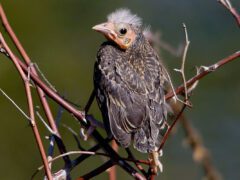The Four Keys to ID
- Size & Shape
A solidly built songbird with a thick-based, sharply pointed, slightly curved bill. Males have a thick neck, especially when they fluff out the feathers of the nape during displays.
Relative Size
Larger than a Brown-headed Cowbird, smaller than an Eastern or Western Meadowlark; similar in size to a Red-winged Blackbird.

 robin-sized
robin-sizedMeasurements
- Both Sexes
- Length: 7.9 in (20 cm)
- Weight: 2.3-2.6 oz (64.9-73.9 g)
- Wingspan: 13.0 in (33 cm)
© Brian Sullivan / Macaulay Library
- Color Pattern
Adult males are blackish with a soft bronze sheen. The wings appear purplish blue at close range. Adult females and juveniles in the eastern part of the range are blackish; in the western part of the range they are grayish brown. Adults have vivid red eyes; juveniles have dark eyes.
© Bryan White / Macaulay Library - Behavior
Forages in flocks, mostly on the ground, searching for seeds, grains, and insects. Males perform a remarkable “helicopter” display to females. Both sexes search for orioles and other birds in the process of building nests; the female stealthily lays eggs in other birds’ nests.
- Habitat
Open habitats such as chaparral, mesquite bosques, coastal prairie, farmland, pasture, golf courses, lightly wooded canyons, and riparian corridors.
© Cole Gaerber / Macaulay Library
Regional Differences
Subspecies loyei of Arizona, New Mexico, and adjacent parts of Mexico, Texas, and California is the largest of the subspecies; females are grayish brown. The subspecies found from Louisiana through Central America, aeneus, is smaller and females are black. The ranges of these two subspecies meet in far western Texas, where both are uncommon. Subspecies assimilis of southwestern Mexico is similar to loyei but smaller. The endangered armenti of northern Colombia, often treated as a separate species (Bronze-brown Cowbird), is smaller still; males are a luminous brown, unlike the other subspecies.


























